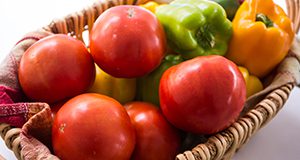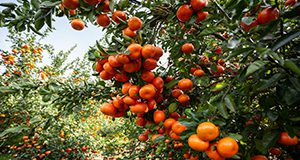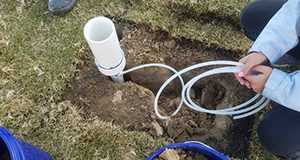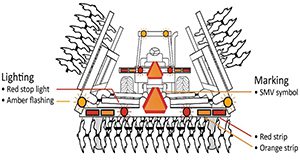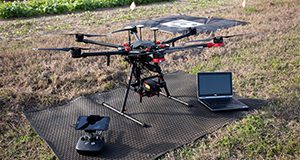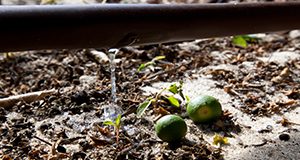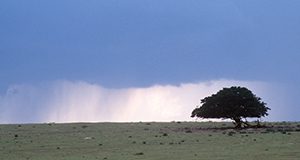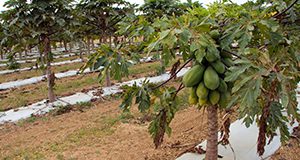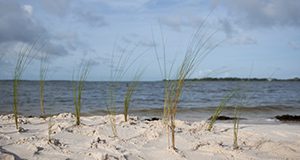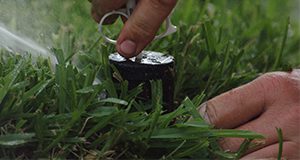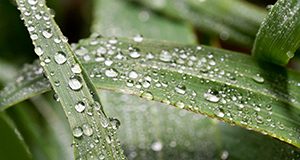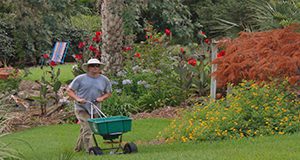Florida's K–12 schools provide a potential opportunity to increase market channel options for small- and mid-sized diversified farms, but processing, storage, and distribution resources are extremely limited for smaller producers. This 9-page document serves as a model and case study with steps for producers and other stakeholders to conduct a feasibility study before forming a cooperative to sell local fruits and vegetables to schools and other institutional food-service outlets. Written by Jonathan Adam Watson, Danielle D. Treadwell, Catherine Campbell, and Ray Bucklin, and published by the UF/IFAS Department of Agricultural and Biological Engineering, March 2021.
https://edis.ifas.ufl.edu/ae555
Tag: Agricultural and Biological Engineering Department
Common Questions When Using Soil Moisture Sensors for Citrus and Other Fruit Trees
This guide is for Extension personnel who may encounter questions from growers about the functioning and accuracy of soil moisture sensors (SMSs) for fruit tree production. The 4-page publication focuses on two types of handheld sensors currently used in Florida for irrigation management of citrus and other trees: the transmission line oscillator (TLO) and time-domain transmissometer (TDT). Written by Eric Herrera, Sandra M. Guzmán, and Eduart Murcia, and published by the UF/IFAS Department of Agricultural and Biological Engineering, February 2021.
https://edis.ifas.ufl.edu/ae551
Design, Construction, and Installation of a Drainage Lysimeter for Use on Sandy, Well-Drained Soils under Turfgrass
Using lysimeters to collect water quality samples can provide a better understanding of nutrient or other solute migration below the surface, which can inform landscape management for environmental protection. This 6-page publication presents the materials, construction, installation, and management of a specific drainage lysimeter design in a step-by-step format. Written by Jovana Radovanovic, Eban Z. Bean, and Alexander J. Reisinger, and published by the UF/IFAS Department of Agricultural and Biological Engineering, February 2021.
https://edis.ifas.ufl.edu/ae554
Lighting and Marking of Agricultural Equipment on Highways: Summary of ASAE Standard S279.18
Agricultural vehicles on public roads can pose risks to their drivers and to drivers of other vehicles. Proper lighting and marking increase visibility of the farm equipment. This 6-page publication summarizes agricultural equipment lighting and marking standards. Written by Serap Gorucu, Charles Brown, and Carol Lehtola, and published by the UF/IFAS Department of Agricultural and Biological Engineering, revised February 2021.
https://edis.ifas.ufl.edu/ae175
Applications of Unmanned Aerial Systems in Agricultural Operation Management: Part III: Best Practices for Efficient Aerial Surveying
With the increasing use of unmanned aerial systems (UASs) in the agricultural domain, ensuring the consistency and completeness of aerial surveys is critical in order to establish repeatability and consistency in data collection activities. This publication covers five main steps to ensure that aerial data collections are repeatable and consistent among missions. It is one of a three-part series focusing on the applications, configuration, and best practices for using UASs in agricultural operations management. Written by Aditya Singh and James Fletcher, and published by the UF/IFAS Department of Agricultural and Biological Engineering, February 2021.
https://edis.ifas.ufl.edu/ae553
Applications of Unmanned Aerial Systems in Agricultural Operation Management: Part II: Platforms and Payloads
Unmanned aerial systems (UASs, UAVs, or drones) have emerged as an important tool for farmers, Extension agents, and landowners to map, monitor, and manage their properties. This 5-page publication provides an overview of the primary components of typical UASs to help growers, landowners, and/or Extension agents who want to configure and/or purchase a UAS or sensor system for agricultural operations. This document is one of a three-part series focusing on the applications, configuration, and best practices for using UASs in agricultural operations management. Written by Aditya Singh and James Fletcher, and published by the UF/IFAS Department of Agricultural and Biological Engineering, February 2021.
https://edis.ifas.ufl.edu/ae552
Publicly Available Geographic Information Sources and Common Analysis Tools
Geographic information and geospatial data are vital in many practical fields, including precision agriculture, natural resources management, flood zone mapping and management, and environmental assessment. This 6-page publication introduces publicly available geospatial data, including elevation, land use, soil, satellite imagery, and other thematic maps and GIS software commonly used in spatial analysis. Written by Satbyeol Shin and Young Gu Her, and published by the UF/IFAS Department of Agricultural and Biological Engineering, January 2021.
https://edis.ifas.ufl.edu/ae550
Consejos Basicos para Disenar Sistemas Eficientes de Riego
Este documento provee un panorama básico de los factores más importantes al diseñar. Written by Haimanote K. Bayabil, Kati W. Migliaccio, Michael Dukes, Laura Vasquez, and Carlos Balerdi, and published by the UF/IFAS Department of Agricultural and Biological Engineering, December 2020.
https://edis.ifas.ufl.edu/ae549
How to Structure Data from an IoT Monitoring Network
The Internet of Things, or IoT, refers to the billions of physical devices that collect and share data through the Internet. This 5-page publication discusses the typical attributes in IoT monitoring networks and presents a data structure that outlines best practices in organizing data. Written by Ziwen Yu, and published by the UF/IFAS Department of Agricultural and Biological Engineering, November 2020.
https://edis.ifas.ufl.edu/ae548
How Is Our Future Climate Projected?
Climate is the long-term patterns and fluctuations in air and moisture. This 5-page article explains how future climate is projected using mathematical models and introduces common scientific terms used when discussing climate change. Written by Young Gu Her, Zachary Brym, Ashley Smyth, and Elias Bassil, and published by the UF/IFAS Department of Agricultural and Biological Engineering, November 2020.
https://edis.ifas.ufl.edu/ae546
Programacion de Riego Basado en el Metodo de Evapotranspiracion Para Papaya (Carica papaya) en Florida
La papaya es un importante cultivo frutícola que se cultiva en el sur de Florida con un área estimada de 356 acres. Este documento se centra en las técnicas de programación de riego basadas en ET para la papaya en las condiciones de Florida. Written by Haimanote K. Bayabil, Jonathan H. Crane, Kati W. Migliaccio, Yuncong Li, Fredy Ballen, and Sandra Guzmán, and published by the UF/IFAS Department of Agricultural and Biological Engineering, November 2020.
https://edis.ifas.ufl.edu/ae547
How Are Our Future Agriculture and Natural Resources Projected under Varying Climate?
This 8-page article explains how agriculture and natural resources may respond to projected future climate and how climate projections can be useful in developing management plans for the improved sustainability of Florida's agriculture and natural resources. It also aims to help increase the public awareness of climate change impacts on Florida and improve understanding of the connections among climate, agriculture, and natural resources. Written by Young Gu Her, Ashley Smyth, Zachary Brym, and Elias Bassil, and published by the UF/IFAS Department of Agricultural and Biological Engineering, September 2020.
https://edis.ifas.ufl.edu/ae545
Online Sources for Sea Level Rise Education and Extension
The impacts of sea level rise on ecosystems and natural resources are a major concern in Florida, especially in low-lying coastal areas such as south Florida. Sea level rise can impact many aspects of Florida's economy, including urban development, agriculture, infrastructure, and natural areas. This 16-page document introduces, evaluates, and summarizes selected available online sources and tools to educate diverse stakeholders and concerned local residents on important aspects of sea level rise. Written by Young Gu Her, Ashley Smyth, Jiangxiao Qiu, Elias Bassil, Ulrich Stingl, and Laura Reynolds, and published by the UF/IFAS Department of Agricultural and Biological Engineering, June 2020.
https://edis.ifas.ufl.edu/ae543
Applications of Unmanned Aerial Systems in Agricultural Operation Management: Part I: Overview
Unmanned aerial systems (UASs, UAVs, or drones) have emerged as one of the most promising technologies for agricultural operation management in recent decades. This 6-page publication provides an overview of the broad areas where UASs can be utilized for monitoring and managing farm operations. Written by James Fletcher and Aditya Singh, and published by the UF/IFAS Department of Agricultural and Biological Engineering, June 2020.
https://edis.ifas.ufl.edu/ae541
Florida H2OSAV Insights: Home Water Use in the Gainesville Regional Utilities (GRU) Service Territory
This 6-page fact sheet discusses basics about water consumption for single-family, detached homes served by Gainesville Regional Utilities, information about the highest water users, and impacts of irrigation on water consumption. Written by Nick Taylor, Kaitlin Olander Robb Price, Bradley Spatz, Tricia Kyzar, and Pierce Jones, and published by the UF/IFAS Department of Agricultural and Biological Engineering, September 2020.
https://edis.ifas.ufl.edu/ae544
How to Avoid Common Problems with Leaf Wetness Sensor Installation and Maintenance
Leaf wetness duration is an essential input in disease prediction models and decision support systems in Florida and elsewhere. Incorrect installation or lack of regular maintenance of leaf wetness sensors may lead to errors in plant disease risk monitoring and negative impacts on yield. This 7-page publication provides detailed guidelines for the proper installation and maintenance of leaf wetness sensors and describes the most common problems found in field installations as well as potential solutions. Written by T. B. Onofre, C. W. Fraisse, N. A. Peres, and J. McNair, and published by the UF/IFAS Department of Agricultural and Biological Engineering, February 2020.
https://edis.ifas.ufl.edu/ae538
Basic Tips for Designing Efficient Irrigation Systems
As freshwater resources become increasingly scarce and droughts become more frequent, there is a need for efficient use of water resources. Designing efficient irrigation systems and equipment will not only save money but also conserve water. This 10-page fact sheet discusses factors to consider when designing irrigation systems. Written by Haimanote K. Bayabil, Kati W. Migliaccio, Michael Dukes, and Laura Vasquez, and published by the UF/IFAS Department of Agricultural and Biological Engineering, February 2020.
https://edis.ifas.ufl.edu/ae539
ET-Based Irrigation Scheduling for Papaya (Carica papaya) in Florida
Three irrigation scheduling methods (set schedule, ET-based, and tensiometer-based) were tested for papaya production in south Florida. ET-based irrigation scheduling was found to conserve water effectively. This 6-page document primarily focuses on the ET-based irrigation scheduling techniques for papaya under Florida conditions. Written by Haimanote K. Bayabil, Jonathan H. Crane, Kati W. Migliaccio, Yuncong Li, and Fredy Ballen, and published by the UF/IFAS Department of Agricultural and Biological Engineering, March 2020.
https://edis.ifas.ufl.edu/ae540
Urban Fertilizer Ordinances in the Context of Environmental Horticulture and Water Quality Extension Programs: Frequently Asked Questions
Excess nitrogen (N) and phosphorus (P) in water bodies are a leading cause of water quality degradation statewide. More than 50 Florida counties and municipalities now have formal fertilizer ordinances, which in some cases include fertilizer blackouts, or bans on the usage of N and P fertilizers during certain times of the year. This 8-page document provides information on the underlying issues of fertilizer use, with an emphasis on an urban setting, and outlines the current state of the science on urban fertilizers and water quality in Florida. Written by Michael D. Dukes, Lisa Krimsky, Mary Lusk, Laurie Trenholm, Bryan Unruh, Michelle Atkinson, and Rao Mylavarapu, and published by the UF/IFAS Department of Agricultural and Biological Engineering, February 2020.
https://edis.ifas.ufl.edu/ae534
What Does Florida Weather during the Past 20 Years Look Like?: Florida Weather Represented by the Florida Automated Weather Network (FAWN)
This 8-page document gives an overview of Florida temperature and rainfall during the past 20 years based on historical FAWN data to provide information about the temporal and spatial trends of Florida weather and the frequency and size of extreme weather events such as heavy rainfall and drought. This document also investigates the characteristics of drought and heavy rainfall in relation to hurricanes and tropical storms. Written by Satbyeol Shin, Young Gu Her, Geraldina Zhang, and William Lusher, and published by the UF/IFAS Department of Agricultural and Biological Engineering, January 2020.
https://edis.ifas.ufl.edu/ae537
